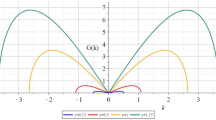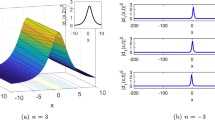
Overview
- Provides a unique interdisciplinary treatment of the nonlinear Schrödinger equation, combining rigorous analysis, informal analysis, numerical methods and physics
- Presents all the necessary physical background, and assumes only that the reader has taken an introductory class in partial differential equations
- Carefully explains the theory, application and background of the nonlinear Schrödinger equation in nonlinear optics
- Covers the theory of NLS collapse from the early 1960s and up to the present
- Includes supplementary material: sn.pub/extras
Part of the book series: Applied Mathematical Sciences (AMS, volume 192)
Access this book
Tax calculation will be finalised at checkout
Other ways to access
About this book
This book is an interdisciplinary introduction to optical collapse of laser beams, which is modelled by singular (blow-up) solutions of the nonlinear Schrödinger equation. With great care and detail, it develops the subject including the mathematical and physical background and the history of the subject. It combines rigorous analysis, asymptotic analysis, informal arguments, numerical simulations, physical modelling, and physical experiments. It repeatedly emphasizes the relations between these approaches, and the intuition behind the results.
The Nonlinear Schrödinger Equation will be useful to graduate students and researchers in applied mathematics who are interested in singular solutions of partial differential equations, nonlinear optics and nonlinear waves, and to graduate students and researchers in physics and engineering who are interested in nonlinear optics and Bose-Einstein condensates. It can be used for courses on partial differential equations, nonlinear waves, and nonlinear optics.
Gadi Fibich is a Professor of Applied Mathematics at Tel Aviv University.
“This book provides a clear presentation of the nonlinear Schrodinger equation and its applications from various perspectives (rigorous analysis, informal analysis, and physics). It will be extremely useful for students and researchers who enter this field.”
Frank Merle, Université de Cergy-Pontoise and Institut des Hautes Études Scientifiques, France
Similar content being viewed by others

Keywords
Table of contents (39 chapters)
-
Front Matter
-
NLS in Nonlinear Optics I
-
Front Matter
-
-
Rigorous Analysis
-
Front Matter
-
-
Asymptotic Analysis of the Critical NLS
-
Front Matter
-
Reviews
“The Nonlinear Schrödinger Equation (NLS) theory was an object of great interest during last decades. … the present book includes almost all questions connected with theoretical and experimental investigations of the above mentioned matter during the years since 1960 until now. … the book abounds in recent results, facts and examples that makes it very interesting for the researchers who work actively in this field.” (Dimitar A. Kolev, zbMATH, 1351.35001, 2017)
“This monograph is devoted to the analysis of optical collapse modelled by the nonlinear Schrödinger (NLS) equation. … The book contains everything a modern reader wants to learn about the NLS equation. … The book is a nice addition to the existing literature on the subject of the NLS equation. New and experienced researchers alike may use this text to get the latest informationabout the state-of-the-art in the field.” (Dmitry E. Pelinovsky, Mathematical Reviews, April, 2016)
Authors and Affiliations
About the author
Gadi Fibich is a Professor of Applied Mathematics at Tel Aviv University.
Bibliographic Information
Book Title: The Nonlinear Schrödinger Equation
Book Subtitle: Singular Solutions and Optical Collapse
Authors: Gadi Fibich
Series Title: Applied Mathematical Sciences
DOI: https://doi.org/10.1007/978-3-319-12748-4
Publisher: Springer Cham
eBook Packages: Mathematics and Statistics, Mathematics and Statistics (R0)
Copyright Information: Springer International Publishing Switzerland 2015
Hardcover ISBN: 978-3-319-12747-7Published: 13 March 2015
Softcover ISBN: 978-3-319-37596-0Published: 06 October 2016
eBook ISBN: 978-3-319-12748-4Published: 06 March 2015
Series ISSN: 0066-5452
Series E-ISSN: 2196-968X
Edition Number: 1
Number of Pages: XXXI, 862
Number of Illustrations: 102 b/w illustrations, 100 illustrations in colour
Topics: Partial Differential Equations, Atomic, Molecular, Optical and Plasma Physics, Classical Electrodynamics, Applications of Nonlinear Dynamics and Chaos Theory



